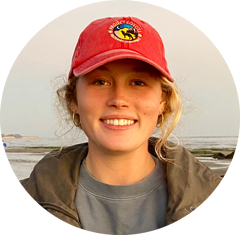Lilah McCormick served as a Project Coyote intern in 2021 and is currently attending Stanford University studying marine biology. She grew up backpacking, hiking and exploring, and is passionate about wildlife conservation. Her internship with Project Coyote allowed her to combined all her interests — research, communications, art, advocacy and education — into a holistic approach to conservation.
An interview with Melinda Modisette by Project Coyote intern, Lilah McCormick
Eighteen-year-old Melinda Modisette has lived around coyotes for her entire life. Until she read Coyote America by Project Coyote Ambassador Dan Flores, she had no idea that humans have waged war on coyotes for centuries, and continue to do so today. And once she knew, she set out to illuminate the glaring disconnect between humans and wildlife through a stunning and haunting painting that will be hung in the U.S. Capitol for the next year. She titled it after her inspiration: Coyote America.
Modisette recently graduated from Albuquerque Academy in Albuquerque, New Mexico. I talked with her by video conference while she was sitting in the passenger seat of her car on her way to Boston for her first year at Harvard University. She will study mechanical or electrical engineering, minor in visual arts, and be on the club wrestling team.
Growing up in the New Mexico desert, “coyotes are pretty much everywhere,” she says. They romp around her high school and in the city, and she falls asleep to the sound of their yipping at night. She loves seeing them around, going about their business, but her favorite encounters are the ones where a coyote stops and stares back at her, observing her just as she is observing the animal. She says, “To look into their eyes is a very serene moment.” She looks at the coyote and sees an animal every bit as intelligent and self-aware as she is.
Though coyotes have been a part of Modisette’s surroundings since she opened her eyes, she, like most Americans, didn’t know about the threats coyotes face at the hands and weapons of humans — until reading Coyote America.
Coyotes are some of the most persecuted animals today. An estimated 500,000 coyotes are killed by humans a year, which averages out to about one coyote per minute. Despite concrete science demonstrating otherwise, coyotes have long been viewed as cunning pests and a menace to other wildlife and livestock — particularly in rural and agricultural areas. As a result, humans have undertaken a centuries-long extermination effort, employing traps, poisons, firearms, calling devices, dogs, and a slew of other cruel instruments to kill them en masse.
All to no avail. Coyotes, as Flores writes in his book, are extraordinarily resilient, much like our own species, and will alter the size of their litters in response to current threats, population status, prey base and other ecological factors.
The book struck a personal chord for Modisette. “My mother’s from China, and she’s a first generation immigrant, and she’s made a beautiful life for me here. There’s a connection there between humans and coyotes. We can both make anywhere home. And we both find ways to thrive even when times are hard.”
Through her work, Modisette illustrates the interdependence and connection that humans have with coyotes and other predators. She says that cartoons like Looney Tunes and Tom & Jerry tend to cast the predators as dumb, hungry, and trying to throw off the balance. “It’s really important as an artist to portray more realistically how much predators are needed to maintain balance in the world.” Modisette’s painting gives her a voice on the matter, and she shares her beliefs through her many artistic choices.
At first glance, the featured coyote is radiant and majestic, and is inseparable from the surrounding landscape. She says, “I wanted the first impression of my piece to be beautiful, but I wanted the viewers to understand the cruelty that goes on in this country upon a closer look.” So she painted a bloody trap around the coyote’s hind leg. The coyote’s shadow morphs into the shadow of a man holding a rifle in one hand and poison in the other. From the right side of the canvas extends a gun, aimed at the coyote’s throat. Modisette says, “While the coyote hasn’t been shot yet, I painted the desert in front of the coyote’s chest blood red, to foreshadow that this is what will happen, and this is what has happened to coyotes before, all the time.”
When reading Flores’ book, she was struck by how the public is constantly misled to believe that programs like the U.S. Department of Agriculture’s “Wildlife Services” protect wildlife, when in fact they lead eradication campaigns. She says, “Coyote America taught me that if you just look a little bit closer, you see all the brutality that goes on, and I want my piece to be a part of that.”
Coyote America won the 2021 Congressional Art Competition for Modisette’s district, and will hang in the U.S. Capitol building for the next year, where undoubtedly, many people will stop to look. Whether or not they look hard enough to notice the distressing details remains to be seen. Those who do will not be able to unsee them.





